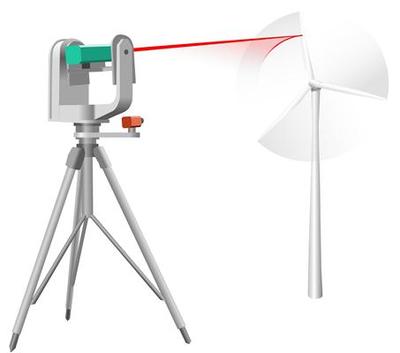Remote measurement of wind turbine oscillations
The Fraunhofer Institute of Optronics, System Technologies and Image Exploitation (IOSB) has created a way to remotely measure the oscillatory pattern of the rotors and masts of wind turbines. Analysis of these oscillations was previously only possible at discrete points located directly on the equipment, but can now be conducted over the entire structure of the facility from several hundred metres away.
“Wind turbines oscillate with displacements of up to a metre in magnitude, even at normal wind speeds,” said Dr Ilja Kaufmann from the Optronics Department of IOSB. “This represents a large load for the material, which can lead to damage and, worst case, to failure of an installation.”
For this reason, operators continuously check how strong the oscillations are by using sensors built into the mast and rotor blades. The disadvantage of this approach is that measurements are only made at the locations where the sensors were mounted; according to Dr Kaufmann, “Obtaining a comprehensive oscillatory pattern over the entire installation is impossible using this technology.”
Dr Kaufmann and his colleagues developed a system for remote oscillation analysis that is able to measure the oscillations at all points on the surface. The centrepiece of the system is an IT-based tracking system combining a camera and a laser, which are mounted on a head that can pan and tilt to follow the rotor blades.
The camera records images of the installation and forwards these along to software that processes the images and builds a model of the rotary motion from the data. With the help of this information, the pan and tilt head is positioned so that the laser automatically follows the rotor blades. The camera simultaneously collects data about the exact position of the 2-3 cm laser spot on the rotor blade in order to stabilise it on the revolving surface.

As many points on the equipment that are needed can be scanned during operation, even from a great distance. “Considerably more comprehensive analyses can be carried out very quickly than are possible using fixed sensors,” said Dr Kaufmann. “The measurement interval is variable: the slower the oscillations, the longer the laser takes measurements.”
The system is compact and can be easily transported to the desired position using a vehicle. Due to its extended range, offshore installations can be examined from on board a ship, assuming compensation for the ship’s own movement.
“Many wind farms in Germany have been running a good 20 years already - often the maximum operating life,” said Dr Kaufmann.
“We can provide decision-making assistance for questions like ‘Is it in good enough shape that I can continue to operate it, or should I sell it and build a new one at the same site?’”
A prototype of the system will be on display at CeBIT 2014, to be held in Hanover, Germany, from 10-14 March.
Canadian Solar and Flow Power to install anti-hail solar
Canadian Solar's anti-hail technology is set to be installed at a new South Australian solar...
Startup secures patent for energy storage technology
Australian startup Allegro Energy has been granted a US patent for its modular micro-emulsion...
New partnership to produce renewable hydrogen derivatives
Climate Impact Corporation has announced its memorandum of understanding with Topsoe to...










